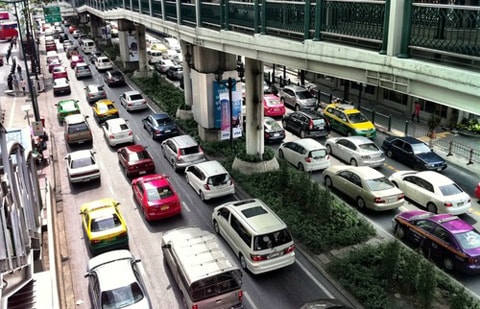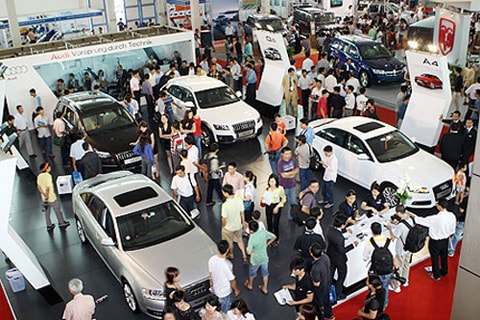Cheap cars, when will it be Vietnam's turn?
In the same ASEAN bloc, while people in Thailand and Indonesia can easily buy cars at cheap prices, in Vietnam, car prices are too expensive. The dream of buying a cheap car is still too far away.
Looking at Thailand, Indonesia is jealous
In Indonesia, five years ago, the government planned to develop small, low-cost cars. Low-cost cars were defined as having a price range of $4,400 to $7,400, with a maximum fuel consumption of 5 liters/100 km. The localization rate was required to be 60%.
Indonesia's goal is to give people with average incomes the opportunity to own cars, while increasing production and developing the auto industry. Seizing the opportunity to export cars to the Southeast Asian market, according to the commitment of the AFTA free trade agreement. Indonesia applies two basic tax rates: import tax and luxury tax like the special consumption tax in Vietnam.
Import tax is 40% for complete vehicles. If assembled in CKD form, import tax is 10% and if assembled in IKD form, tax is 7.5-8%.
Luxury tax is divided by engine capacity, ranging from 30-75%. For strategic cars with a localization rate of over 60%, the luxury tax is only 10%. For low-cost cars, the luxury tax is completely exempted. This policy has been stable for the past 5 years so that businesses can have long-term investment plans.
As a result, a series of low-cost car models have been launched to meet the needs of the people. The common people in Indonesia can now easily buy a car priced under 10,000 USD with a 1.0L engine such as Mitsubishi Mirage, Daihatsu Ayla, Honda Brio Satya...
 |
| Cars in many countries in the region are a dream of Vietnam. |
Indonesia also faces traffic jams every day. Many people use cars as a means of transportation, so traffic jams are inevitable. But the Indonesian government believes that many cars require the authorities to have a vision and focus on infrastructure to make transportation more convenient.
Indonesia said that with this method, they get many benefits, not only people have access to cars, but also develop the auto industry; not only meet domestic demand but also export.
The development of the automobile industry creates many jobs and generates a large source of revenue for the budget. When there is money, it will be reinvested in developing the transport infrastructure system. In addition, when the automobile industry develops, it will pull many industries such as electronics, steel, new materials, metallurgy, engine manufacturing, etc. to develop, creating a foundation for a country with a modern industry.
Thailand has also been very successful with the "eco-car" project. Since 2009, the Government has stipulated that "eco-cars" have a maximum fuel consumption of 5 liters/100 km, meet Euro 4 emission standards and are entitled to high tax incentives.
The Thai government also has a policy to support first-time car buyers by reducing the special consumption tax by 3,200 USD. Thanks to that, over time, many cheap car models have been born to meet the needs of the people.
In Thailand, the capital Bangkok is also frequently congested by cars, but the government has no policy to limit cars. Thailand will solve traffic congestion by using revenue from cars to build elevated trains, subways, etc. to encourage people to use public transport. In addition, the government calls on businesses to build elevated roads and collect tolls to recover capital.
Nowadays in Thailand there are many cheap cars and most Thai families from rural to urban areas have cars and many families have 2 cars.
When will you come to Vietnam?
In Vietnam, since 1995, the automobile industry has begun to develop. More than 10 famous automobile companies in the world have come to invest in car assembly. The Vietnamese automobile industry has failed because it mainly stopped at assembly, with a very low localization rate for simple components.
Recently, summarizing 10 years of automobile development, the important criteria of an automobile industry from vehicle production to localization rate... were not achieved. Important goals that show the development of the automobile industry such as: engine production, gearbox, transmission assembly... all failed.
In particular, the supporting industry is very underdeveloped. Up to now, the whole country has about 210 enterprises participating in the production of auto components and spare parts, but they are mainly simple, low-value components. The total number of supporting enterprises in Vietnam is only 1/5 compared to Indonesia, 1/8 compared to Thailand. While Thailand has an output of 1.5 million vehicles/year, Indonesia has 1.2 million vehicles/year, in 2013 Vietnam has reached 110,000 vehicles/year.
 |
| Owning a car in Vietnam is still considered a luxury. |
Meanwhile, policies are suffocating the market, and consumers are being squeezed by piled-up taxes and fees. This is also the main reason for the high price of cars. A car in Vietnam is subject to 5 types of taxes and 9 types of fees. Taxes on top of taxes, fees on top of fees make the majority of Vietnamese people not dare to think about buying a car.
On the part of enterprises, usually low exploitation capacity leads to losses and according to market rules, those who operate inefficiently will have to withdraw. However, no enterprise withdrew and joint ventures still made profits, which proves that the selling price of cars has been pushed up much higher than the real value of the cars.
In Vietnam, traffic congestion is the reason for car restrictions. The Ministry of Transport once had an initiative to charge car fees of 30-50 million VND/car/year and the following year it was 20% higher than the previous year, causing many consumers to panic.
To date, car prices in Vietnam are still among the most expensive in the world. In Thailand, the Toyota Yarris E version costs 17,700 USD, but when imported to Vietnam, the price is up to 661 million VND. The Suzuki Swift assembled in Vietnam costs 550 million VND, but in Thailand, the price is only 15,000 USD.
Thailand’s per capita income in 2013 was over 10,000 USD, and Indonesia’s was over 5,000 USD, while Vietnam’s was less than 2,000 USD/person/year. However, car prices in Vietnam are 1.5 times higher than in these two countries.
Through that, we can see how easy it is for Thai and Indonesian people to access cars, while for Vietnamese people it is still just a distant dream.
According to vietnamnet
